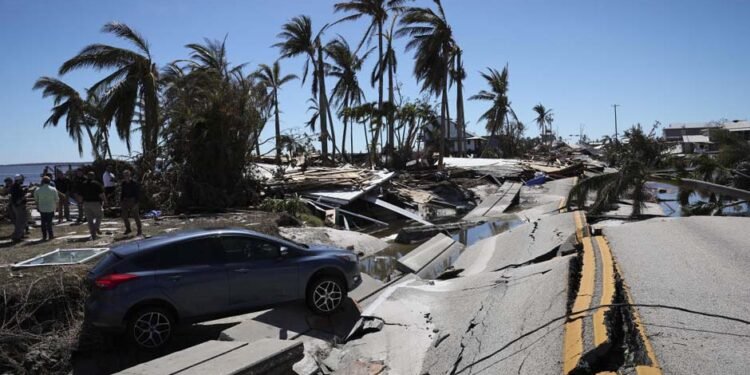Key Takeaways
Climate change is significantly impacting the intensity and frequency of hurricanes.
Scientific data and research reveal alarming trends in hurricane behavior.
Adaptive measures are crucial to mitigate the adverse effects of these phenomena.
Introduction to Hurricane Dynamics
Hurricanes, also called tropical cyclones, are highly intense storm systems that form over warm ocean waters. They are marked by powerful winds, torrential rainfall, and significant storm surges that can devastate coastal areas. Hurricanes can vary in intensity, with the most severe classified as a category 5 hurricane. These storms have sustained winds exceeding 157 mph, causing catastrophic damage to infrastructure, ecosystems, and human settlements. Understanding the intricacies of hurricane dynamics, including their formation, development, and eventual dissipation, is crucial for predicting their impact and implementing effective preparedness measures.
Climate Change and Its Effects on Weather Patterns
Climate change encompasses long-term shifts in temperature and weather patterns, primarily driven by human activities such as industrialization, deforestation, and the burning of fossil fuels. These activities have significantly increased the concentration of greenhouse gases in the atmosphere, leading to a rise in global temperatures. This warming effect has far-reaching consequences on various weather phenomena, including hurricanes. Warmer ocean temperatures provide the essential heat energy required to fuel hurricanes, making them more potent and destructive. Scientists have established a clear correlation between rising temperatures and increased intensity and frequency of hurricanes. The implications of this relationship are profound, as it suggests a future marked by more frequent extreme weather events that pose significant challenges to communities worldwide.
Scientific Data on Increased Hurricane Intensity
Historical data reveals that the number of high-intensity hurricanes, particularly those classified as Category 4 and 5, has increased over the past few decades. This trend is closely linked to the warming of ocean waters, which provide the critical energy necessary for hurricanes to form and strengthen. Studies conducted by reputable institutions such as the National Oceanic and Atmospheric Administration (NOAA) corroborate these findings, highlighting an alarming rise in hurricane activity. The increase in hurricane intensity has far-reaching implications, including greater damage to infrastructure, higher economic costs, and more significant disruptions to human and ecological systems.
Rising Sea Levels and Coastal Impacts
Rising sea levels are one of climate change’s most direct and visible consequences. This rise poses a significant threat to coastal regions, making them more vulnerable to the impacts of hurricane-induced storm surges and flooding. Even relatively moderate hurricanes can cause substantial damage in areas with rising sea levels, as the increased water levels amplify the extent and severity of flooding. The risks are particularly acute for communities in low-lying coastal regions, as they often lack the robust infrastructure and natural defenses required to withstand such events. Addressing the dual challenges of rising sea levels and more intense hurricanes necessitates comprehensive planning and investment in resilient coastal defenses.
Human Contributions to Climate Change
Human activities have been the primary drivers of the accelerated pace of climate change observed in recent decades. Burning fossil fuels for energy, deforestation to make way for agriculture and urban development, and various industrial processes have significantly increased atmospheric CO2 levels. This accumulation of greenhouse gases traps heat in the atmosphere, leading to global temperature increases and subsequent climate disruptions. Recognizing humans’ significant role in climate change is crucial for developing effective mitigation strategies. Efforts to reduce carbon footprints through adopting renewable energy sources, enhanced energy efficiency, protecting natural habitats, and pursuing a career in carbon capture can significantly contribute to addressing the root causes of climate change. Collective action at individual, community, national, and global levels is imperative to mitigate the adverse effects of climate change and protect future generations.
Adaptive Strategies and Solutions
Given the escalating threat of more intense hurricanes due to climate change, implementing adaptive measures is critical for enhancing resilience and reducing vulnerability. Key adaptive strategies include:
- Improving building codes: Ensuring structures are designed and built to withstand extreme weather conditions can significantly reduce damage and save lives. Updated building codes can mandate the use of hurricane-resistant materials and construction techniques.
- Enhancing early warning systems: Accurate and timely warnings allow communities to prepare and evacuate if necessary, minimizing casualties and harm. Advances in meteorological forecasting and communication technologies play a crucial role in these systems.
- Investing in resilient infrastructure: Strengthening essential infrastructure such as roads, bridges, and utility systems ensures communities recover more quickly after a storm. Resilient infrastructure can withstand the impacts of hurricanes and provide critical services during recovery efforts.
- Adopting sustainable practices: Reducing greenhouse gas emissions and promoting environmental stewardship can lessen the impact of climate change over time. Reforestation, sustainable agriculture, and the transition to renewable energy sources contribute to climate mitigation.
Implementing these measures requires coordinated efforts from governments, businesses, and individuals to be effective. By prioritizing resilience and sustainability, societies can better protect vulnerable populations and assets from the increasing threats posed by climate change-driven hurricanes.
Future Outlook and Predictions
Looking ahead, the future trajectory of hurricane activity will be heavily influenced by the actions taken today. While some changes induced by past emissions are inevitable, the extent of future impacts can be mitigated through proactive and collaborative efforts. Scientists continue to refine climate models and improve predictive capabilities, providing valuable insights for better preparing for extreme weather events. Collaborative efforts between governments, researchers, and communities are essential for developing effective mitigation and adaptation strategies. Policies aimed at reducing carbon emissions, enhancing climate resilience, and promoting sustainable practices are critical for shaping a future where the impacts of climate change are minimized.












